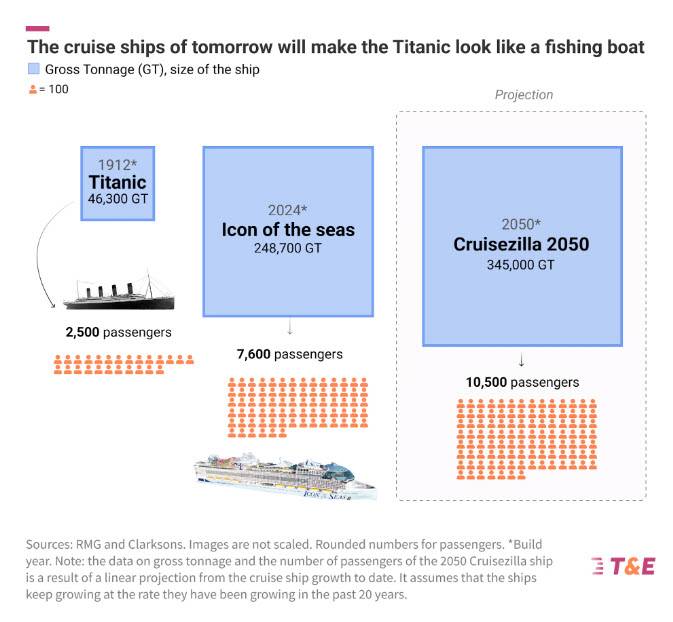Cruisezilla? Modern Cruise Ships Now Dwarf the Titanic
The number and size of cruise ships globally has doubled since the start of the millennium, T&E’s new ‘Cruisezillas: How much bigger can cruise ships get?’ report reveals. If they continue to grow at this rate, the biggest cruise ships in 2050 could be a staggering 345,000 gross tonnage, making them almost eight times bigger than the Titanic.
In January 2024, the world’s largest cruise ship to date, the Icon of the Seas, was launched. The floating city contains 40 restaurants, seven swimming pools and can carry 7,600 passengers. It is longer than 15 blue whales and five times bigger than the Titanic.
The largest ship built before 2005, Voyager of the Sea, was able to carry 3,938 passengers.
Today, the average size of the 10 largest cruise ships is double what it was 24 years ago, averaging 205,000 GT. Additionally, the global cruise industry has boomed over the past half a century, with the number of ships rising 20-fold from only 21 in 1970 to 515 today.

A combination of more and bigger cruise ships means that CO2 emissions from cruise ships in Europe were nearly 20% higher in 2022 than they were in 2019 before the pandemic, and T&E calls on cruise liners to invest in green technologies to reduce their impact on the planet and local air pollution.
Many cruise operators are switching to LNG, and LNG-powered ships make up 38% of global cruise ship orders today. While LNG emits less pollutants and CO2 when burned, it releases methane, a greenhouse gas over 80 times more potent than CO2.
Green e-fuels could power almost 4% of European shipping in 2030, a recent T&E study shows. The limited availability of e-fuels and their bunkering infrastructure should be less of an issue for the cruise ships, says T&E, as they sail on the same routes with clear schedules, making their fuel refueling needs and timings predictable and relatively easy to plan.
It can also be financially beneficial for cruise operators to switch to green fuels, the latest study shows. Due to the EU’s carbon price on ships which took effect from the beginning of this year, and progressively increasing FuelEU Maritime penalties for using the dirtiest shipping fuels from 2025, sailing only on fossil fuel will become 13% more expensive than blending 4% of e-methanol into the fuel mix in 2030. The cost increase when sailing on fossil fuel compared to blending e-fuels could reach more than 30% in 2040 and over 80% in 2050.
Cruise ships are currently exempt from fuel duties, corporate taxes and most of the consumer taxes that other modes of transport are subject to. A €50 ticket tax on a typical cruise ticket would bring in €1.6 billion ($1.7 billion) globally, according to the analysis. This could provide crucial climate finance and ensure that luxury forms of travel are taxed, says T&E.

















